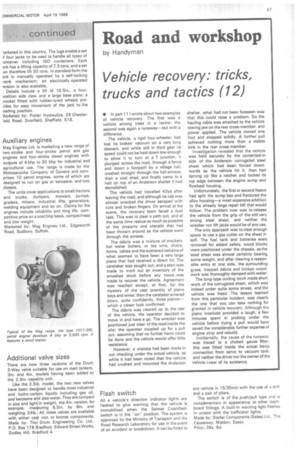Road and workshop
Page 59

If you've noticed an error in this article please click here to report it so we can fix it.
by Handyman
Vehicle recovery: tricks, trucks and tactics (12)
• In part 11 I wrote about two examples of vehicle recovery. The first was a vehicle among trees in a ravine; the second was again a runaway--but with a difference.
The vehicle, a rigid four-wheeler, had lost its brakes' vacuum on a very long descent, and while still in third gear its speed could not be held down low enough to allow it to turn at a T junction. It plunged across the road, through a fence and down a footpath by a village hall, crashed straight through the hall annexe, then a coal shed, and finally came to a halt on top of an Anderson shelter it had demolished.
The vehicle had travelled 43yd after leaving the road, and although its cab was almost wrecked the driver escaped with cuts and broken fingers. On arrival at the scene, the recovery team faced a dual task. This was to clear a path out, and at the same time rescue as much as possible of the property and utensils that had been thrown around as the vehicle went through the annexe.
The debris was a mixture of crockery, hot water boilers, or tea urns, chairs. forms, tables and the scattered remains of what seemed to have been a very large piano that had received a direct hit. The caretaker was sought out, and a start was made to work out an inventory of the smashed stock before any move was made to recover the vehicle. Agreement was reached except, at first, for the mystery of the vast quantity of piano keys and wires; then the caretaker entered down, quite confidently, three pianos— which a closer look confirmed.
The debris was cleared up to the rear of the vehicle, the operator decided to move in and have a go. The wrecker was positioned just clear of the road inside the site; the operator coupled up for a pull out, assuming that no further harm could be done and the vehicle would offer little resistance.
However, a mistake had been made in not checking under the actual vehicle, as while it had been noted that the vehicle had crushed and mounted fhe Anderson shelter, what had not been foreseen was that this could raise a problem. So the hauling cable was attached to the vehicle towing jaw on the rear cross-member, and power applied. The vehicle moved one foot and stopped solidly. A further pull achieved nothing more than a visible kink in the rear cross-member.
Investigation revealed that the vehicle was held securely by the cemented-in side of the Anderson corrugated steel sheet which had been forced downwards as the vehicle hit it, then had sprung up like a ratchet and locked its top edge between the engine sump and flywheel housing.
Unfortunately, the first or second heave had split the sump box and.fractured the alloy housing—a most expensive addition to the already large repair bill that would follow. The problem now was to release the vehicle from the grip of the still very strong steel sheet, and neither the wrecker nor lift jacks would be of any use.
The only approach was to clear enough space to use a gas cutter on the sheet itself. The fuel tank and batteries were removed for added safety, wood blocks were positioned under the chassis, as the steel sheet was almost certainly bearing some weight, and after clearing a reasonable entry at one side, the surrounding grass, trapped debris and broken woodwork was thoroughly damped with water.
The long-type cutting torch made short work of the corrugated sheet, which was indeed under quite some stress, and the vehicle was freed. The lesson learned from this particular incident, was clearly the one that you can take nothing for granted in vehicle recovery. Although the piano interlude provided a laugh, a few minutes spent in probing under the vehicle before trying a pull would have saved the considerable further expense of engine strip and rebuild.
Incidentally, the cause of the runaway was traced to a choked gauze filter; this was fitted inside the actual banjo connection from servo to vacuum tank, and neither the driver nor the owner of the vehicle knew of its existence.








































































































































